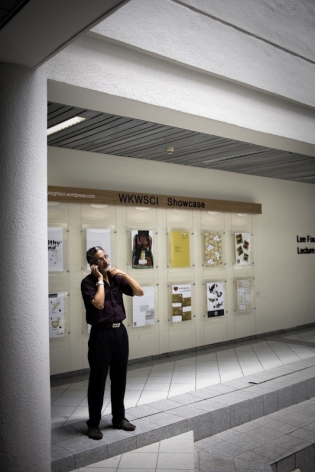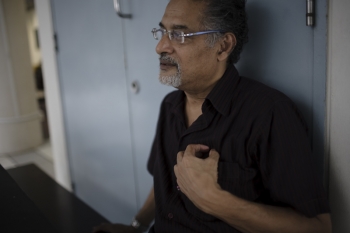What is the future of journalism in Singapore? Even after helming three of Singapore’s largest English dailies, P.N. Balji has no answers on the future of newspapers, only ideas.
Text by Sheere Ng | Photos by Alex Teh
Standing in front of a room filled with seasoned journalists and students, P.N. Balji is incredibly at ease. He leans against the table and props one leg over the edge, revealing his bare ankle and grey suede shoes – just like his suggestions, his sense of style is incredibly wayward.
At a time when newspapers are dying, the director of the Asia Journalism Fellowship is here to talk about the future of journalism. He challenges his audience about the possibilities of a borderless newspaper- one with no clear delineated sections.
Why not let movie reviews appear on the front page? The International Herald Tribune did that with The Dark Knight. How about running the piece on former US secretary of state Madeleine Albright’s jewellery in the prime pages instead of burying it in the lifestyle section? “It’s a fantastic article about how she communicates her mood through the brooches she wears. It is politics, fashion, and personal profile,” he says. “At the end of the day, readers just want to read a good story.”
Although he provides no solution to the newspaper crisis and instead chooses to raise numerous questions that set the room thinking, his journalistic journey may shed some light. After all, the 60-year-old has spent half his life working in The Straits Times (ST), The New Paper (TNP) and Today.
NEWSROOM CHAMELEON
In 1988, Balji left his job as ST’s deputy editor to join the pioneering team of TNP.
At that time there was a vacuum in the marketplace for fresh news to provide different insights. Balji’s team thus launched a tabloid paper that attracted a new group of readers: they are young, they did not read newspapers before, and they only read TNP.
But the man himself is not big on tabloid sensationalism.
“That doesn’t mean I can’t produce it,” he says. “You must divorce yourself from what you like, to give the market what it likes.” Journalists cannot afford to listen only to themselves as they have vested interests and biases, he adds.
Some 12 years later, with ST aiming squarely at the entire English-speaking public, TNP providing tabloid news and Streats, a free commuter tabloid sheet, it just didn’t seem there was a market for another.
“So we created one,” he says. In 2000, Balji joined MediaCorp to set up Today, another commuter tabloid sheet. “We decided that the newspaper should provide news that is ‘not overtly pro-government’ and will tackle issues that The Straits Times will shy away from.”
Today, Singapore’s media landscape looks set to change again. In the US, the mainstream media is wilting under the onslaught of online journalism and Web 2.0. Advertising looks set to shift its operations to capture more of the online audience and demand for print advertising is falling fast.
According to Jeffrey Seah, CEO of Starcom Media Group, a leading multinational advertising company, being able to engage users gives the Internet an important edge over mainstream media in selling advertising space.
Newspapers like ST, on other hand, are facing an uphill task of retaining their audience. With more news sources available on the internet, the public’s reading habits are changing even more quickly. One example would be Balji himself.
According to him, he used to receive the bulk of his information from traditional print media a few months ago. Today, 60 per cent of his information comes from the internet.
He has been relying on the ‘pushing’ of information online by his friends who will forward him any interesting news nuggets they come across. “I do follow blogs like The Online Citizen and Yawning Bread,” says Balji. “But if I start to read news websites like ST Online or CNA (Channelnewsasia), then I will have no time to sleep.”
But his time is not only spent online. His practice of journalism seeps into his everyday life as well.
Pedestrian tasks like grocery shopping and visits to the petrol stations take unusually long for Balji as he tries to take the time to talk to anyone who might come along. “All these little bits of information will hopefully give you the ground feel of what people like and don’t like over time,” he says.
But Balji hasn’t always been this comfortable talking to strangers. He describes himself as “very much an introvert who is trying very hard to be an extrovert”.
Reminiscing, he recalls that his interest in journalism began when he was young. He remembers having to get up as early as possible before his father and younger brother in order to read the family’s only copy of ST in peace. At that time, he was a firm devotee of Norman Siebel’s (former Straits Times Sports Editor) articles.
FROM FIGHTING FOR TO FIGHTING WITH THE STRAITS TIMES
But as he grew older, his relationship with Singapore Press Holdings (SPH) was no longer as filled with bliss. This was because he joined MediaCorp to help launch Today, today seen as a direct competitor to ST.
“Some people might think I’m a traitor,” he admits. But Balji sticks by his philosophy- to “go when the going is good”. Leaving while you are at the top of your game puts your life in your own hands rather than your employer’s, he explains.
This was also why he left TNP earlier on, when the paper was at its dizzying heights. From a circulation of 50, 000, it hit a ceiling of 130, 000 when he left.
Similarly, in 2003, Balji ended his contract with MediaCorp after three years with Today to work in the Public Relations (PR) industry, which some journalism practitioners have dubbed the ‘darker side’. He went on to set up two flourishing PR companies – Bang Public Relations and Communications DNA.
“I would have liked to continue in journalism. But where do I go?” he says. Leaving Singapore Press Holdings (SPH) to join its competitor to start Today has left him with little options.
But when he was asked to return to Today in 2007 when its editor-in-chief, Mano Badnani, left, Balji returned to the fold.
“My first concern was that Today must not go down. Why should we let SPH have the last laugh?” he says. He denies that bad blood exists between him and SPH but merely feels that Singapore journalism can benefit from more competition.
Ironically, it is precisely this lack of competition in the local newspaper industry that may be keeping newspapers here afloat. “If you ask me today: can I throw the Straits Times away? I can’t,” he says. In the West, there are so many competitors that newspapers are winding up or looking to investors for help after incurring millions of dollars in losses.
In Singapore, the lack of alternative news media has bred mediocrity in the standards and professionalism of local news coverage in the mainstream press. “They are surviving only because readers do not have a benchmark to make comparisons with,” says Balji.
Soon after his last contract with Today ended, he tried to set up a full-blown online newspaper like The Huffington Post. But he could not find a viable business model for his publication.
“I only managed to find a cost model, but not a revenue model,” he says. Hence, he feels that the prospect of an alternative online newspaper might not be a viable undertaking for now, yet another reason that is keeping newspapers here safe. But Balji estimates that Singapore has only about five to ten years before the full impact of the fundamental shift in the media landscape is felt.
However, tell-tale signs of this change are popping out. Singaporeans increasingly look to the Internet for news that the mainstream media chooses to ignore or to censor. “This is the biggest problem that the mainstream media faces,” says Balji.
More of such cases have been seen in recent years. For instance, news of the suicide of a Singapore Armed Forces medical officer first broke on the internet before making its way to the papers. Recently, ST also left out questions about Prime Minister Lee Hsien Loong’s pay when it reported an interview he did with the British Broadcasting Corporation (BBC).
“What frustrates Singaporean readers most is that the mainstream media are blocking out news,” he says. “But what is important is that now, they can get it online.”
JOURNALISTS ARE THE GREATEST ENEMY OF JOURNALISM
“The conventional reporting style of “A says this and B says that” no longer satisfy today’s media-savvy readers,” says Balji during his presentation.
Comparing the two instances when he created TNP and Today to fill the voids in the market, he says that the demand for news analysis has become even greater in recent years, and especially so today.
In the recent terrorist attacks on Mumbai, he had stayed up overnight to follow the breaking news on television. That was why he was very disappointed to see the same information in the newspapers the morning after. “Why would people want to read something they already knew about?” he questions.
Not only that, Balji thinks there is a dearth of stories that provide fresh insights and new viewpoints. For example, no one in the mainstream press had questioned why the PM held a press conference after the recent Cabinet reshuffle. “Nothing like that has ever happened in Singapore’s history, but I didn’t see any article helping the reader make sense of it,” he says.
Some say that the self-preservation and self-censorship are reasons why local journalists choose not to delve deeper into such issues. However, Balji feels that journalists cannot see themselves as ordinary citizens with such ordinary fears. “That’s why we go into this profession,” he says.
There is also more required of journalists today. Besides writing, they should also be equipped with other skills like photography and newspaper design. “Newsrooms have a tendency to be overstaffed,” he says. Especially so in bad times, journalists with multiple skills are more likely to be valued.
When he joined ST as a rookie, he chose editor-in-chief, T.S. Khoo as his mentor. To him, Khoo was the best layout designer in Asia at that time and Balji wanted to learn design from him. Daily, the young Balji picked up dummy sheets of the newspaper layout that Khoo had thrown into the waste paper basket.
Putting all the crumpled sheets beside the final published paper, he saw for himself the evolution of the entire design process. “That was a priceless learning experience,” he says
Today’s competitive economic climate also calls for journalist to be more aware of the business of news. “A good journalist must know his market well,” says Balji. Learning the ropes, he suggests, can be as easy as having lunch with colleagues from the advertising and marketing department. Unfortunately, many journalists today either do not know, or do not want to know about advertising and marketing and cite maintaining ‘editorial integrity’ as their excuse.
Balji knows that old mindsets cannot be changed in the span of an hour. So he concluded his presentation with a quote by Rupert Murdoch, a man that journalists claim is threatening their credibility, “Journalists are threatening their own papers”. A dire warning is sounded by the most unlikely of allies – that if journalists today do not change their mindsets, they are liable to bring journalism down with them.
—
This story is part of a series, Where are we going: The future of newspapers in Singapore
—




Brilliant story, Sheere!